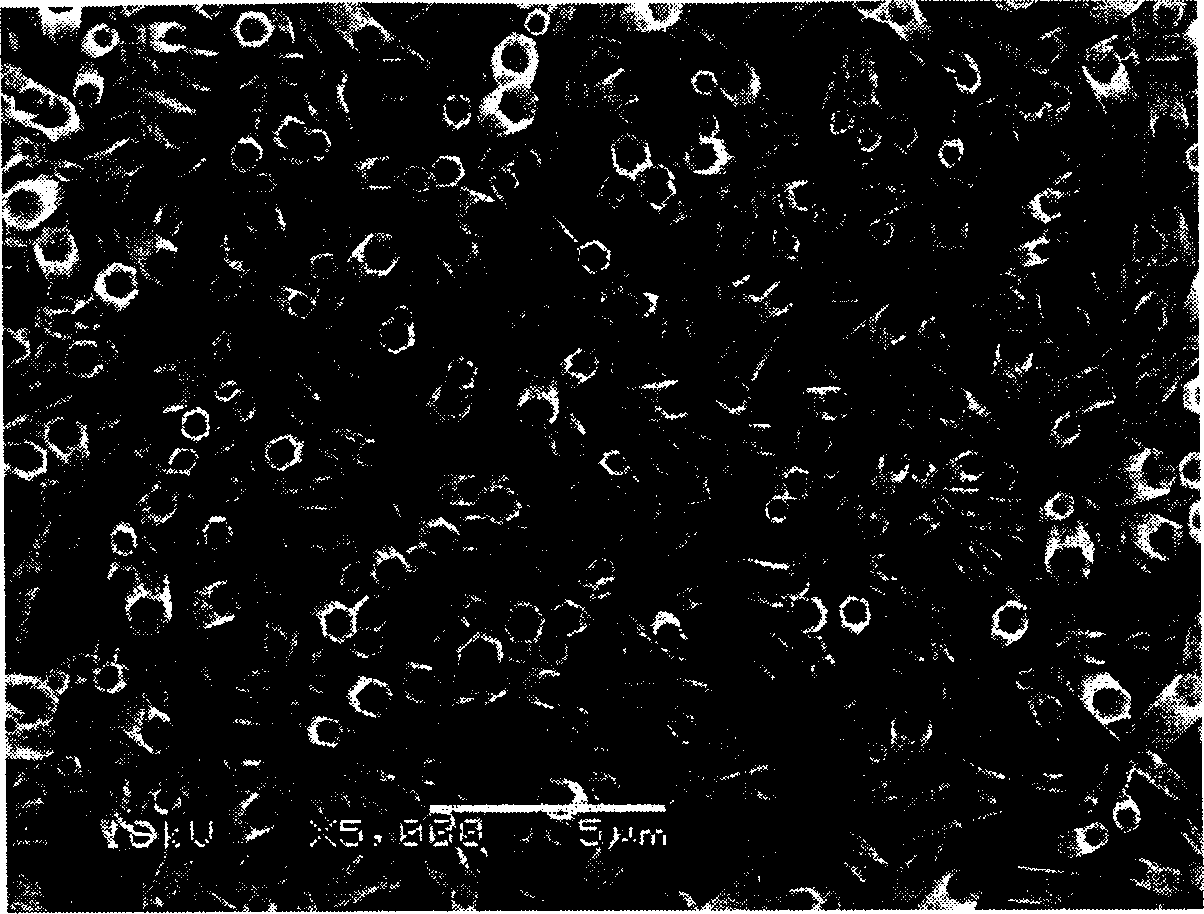Method of growing nano-tube shaped zinc oxide by hydrothermal decomposition
A nanotube and zinc oxide technology, applied in the field of hydrothermal decomposition and growth of nanotube-type zinc oxide, can solve the problems of high reaction temperature, complex equipment, low efficiency, etc., achieve good repeatability, reduce chemical reagents, and improve sample purity Effect
- Summary
- Abstract
- Description
- Claims
- Application Information
AI Technical Summary
Problems solved by technology
Method used
Image
Examples
Embodiment 1
[0021] A method for hydrothermally decomposing and growing nanotube-type zinc oxide:
[0022] The first step: add concentrated ammonia water with a mass percentage concentration of 25% dropwise into a zinc chloride solution with a concentration of 0.06-0.15M and fully stir to adjust the pH of the solution to 9-11, and then seal the solution. This embodiment can Choose to add concentrated ammonia water dropwise to 0.08, 0.10, 0.12 or 0.15M zinc chloride solution, and adjust the pH value of the solution to 9, 9.5, 9.7, 10.1 or 11;
[0023] Step 2: ultrasonically treat the closed solution for 25 to 35 minutes. In this embodiment, the time for ultrasonic treatment is 25, 28, 32 or 35 minutes;
[0024] Step 3: Put the cleaned conductive substrate into the above solution and seal the solution again, then put the sealed solution in an environment of 80-98°C and let it stand for 45-90 minutes. In this embodiment, Put the closed solution in an environment of 90, 95 or 98°C and let it ...
Embodiment 2
[0027] 1. First scrub the stainless steel sheet with acetone, then ultrasonically clean it with acetone and deionized water for 15 minutes each;
[0028] 2. 3ml of concentrated ammonia water with a mass ratio of 25% is added dropwise to 40ml of a 0.10M zinc chloride solution and fully stirred; the solution is placed in a glass bottle with a screw cap.
[0029] 2. Treatment of film growth solution: Seal the above solution and treat it with ultrasonic for 35 minutes;
[0030] 4. Put the cleaned substrate into the solution and seal the solution again. Immediately thereafter, the closed container was placed in an oven at 95° C. for 60 minutes. Then lower the temperature of the oven, keep the substrate for 6 hours, take out the substrate, rinse it with deionized water and dry it naturally to obtain zinc oxide nanotubes with uniform and dense arrangement.
[0031] image 3 The XRD pattern shows that the obtained sample is zinc oxide crystals without other impurities.
[0032] f...
Embodiment 3
[0034] 1. Selection and treatment of the substrate: first scrub the wide-strip tinned silicon substrate with acetone, then ultrasonically clean it with acetone and deionized water for 15 minutes each;
[0035] 2. Preparation of film growth solution: 3ml of concentrated ammonia water with a mass ratio of 25% was added dropwise to 50ml of a 0.12M zinc chloride solution and fully stirred; the solution was placed in a glass bottle with a screw cap.
[0036] 3. Treatment of thin film growth solution: seal the above solution and use ultrasonic treatment for 30 minutes;
[0037] 4. Place the cleaned substrate horizontally into the solution and seal the solution again. Immediately thereafter, the closed container was placed in an oven at 95° C. for 50 minutes. Then lower the temperature of the oven, keep the substrate for 6 hours, take out the substrate, rinse with deionized water and dry naturally to obtain zinc oxide nanotubes with uniform and dense arrangement.
PUM
| Property | Measurement | Unit |
|---|---|---|
| diameter | aaaaa | aaaaa |
| thickness | aaaaa | aaaaa |
| length | aaaaa | aaaaa |
Abstract
Description
Claims
Application Information
 Login to View More
Login to View More - R&D
- Intellectual Property
- Life Sciences
- Materials
- Tech Scout
- Unparalleled Data Quality
- Higher Quality Content
- 60% Fewer Hallucinations
Browse by: Latest US Patents, China's latest patents, Technical Efficacy Thesaurus, Application Domain, Technology Topic, Popular Technical Reports.
© 2025 PatSnap. All rights reserved.Legal|Privacy policy|Modern Slavery Act Transparency Statement|Sitemap|About US| Contact US: help@patsnap.com



